The OFWM Project was launched after more than two decades of research on different aspects of irrigated agriculture in Pakistan. The research, conducted by the Water and Power Development Authority (WAPDA) at the Mona Experimental Station in Punjab, with the assistance of Colorado State University, was the first to reveal the alarming extent of water losses resulting from deteriorated watercourses and inefficient irrigation practices on farms. These early studies identified significant water conveyance losses in watercourses, where on average, 40-50% of the delivered water was lost at the outlet (meaning that about half of the flow at the mogha never reached the fields). The research studies also highlighted the urgent need to address the problem of massive water wastage in watercourse commands. Furthermore, the experiments at Mona resulted in developing and testing new techniques to enhance watercourses, including implementing well-designed channels, partial concrete lining, and installing concrete turn-out structures known as nuccas to prevent watercourse bank erosion.
Constraints
Upon encountering the challenges and limitations, it was evident that a comprehensive plan was necessary to manage water at the farm level.
Flood IrrigationFarmers commonly practice flooding as an irrigation method, which has an efficiency of no more than 50 percent. This results in low irrigation efficiency at the farm level, which significantly hinders the attainment of potential production from otherwise highly productive agricultural lands. Furthermore, more than 40 percent of canal water is lost between the mogha outlet and farmers' fields due to the inadequate condition of the tertiary conveyance system, specifically watercourses. Moreover, irrigation water delivery is supply-based, causing delays in meeting crop water requirements, which ultimately has a negative impact on overall agricultural production. |
Uneven FieldsDuring the application of irrigation water, a notable percentage (20 to 25%) is lost due to uneven fields and poor farm design, leading to excessive water application in low-lying areas and under-irrigation in higher spots. Over-irrigation leaches soluble nutrients from the crop root zone, making the soil less productive and degrading groundwater quality. On the other hand, under-irrigation of elevated areas results in salt accumulation in patches and water stress, as well as harmful effects of applied fertilizer. |
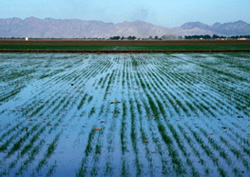 |
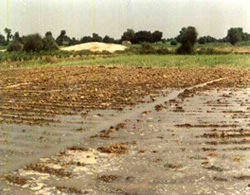 |
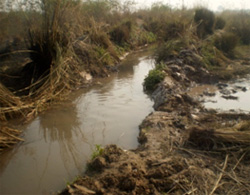 |
Irrigation Inefficiency
As per the Water Accord of 1991, the total surface water allocation for Punjab is 41.82 million hectare meters (55.54 MAF). However, the distribution network, consisting of main/branch canals, distributaries, minors, and tertiary conveyance systems, comprising more than 58,000 watercourses, results in substantial water losses. Furthermore, there are significant losses (30-35%) at the farm level. As a result, only 16-19 million hectare meters (22-25 MAF) of surface water are available at the farm gate, which is inadequate for sustainable irrigated agriculture. To compensate for this shortfall, groundwater abstraction is about 22-26 million hectare meters (30-35 MAF). The water budget of the Punjab irrigation system is depicted below, making it crucial to adopt a comprehensive on-farm water management (OFWM) approach for utilizing scarce water resources more effectively and efficiently at the farm level.
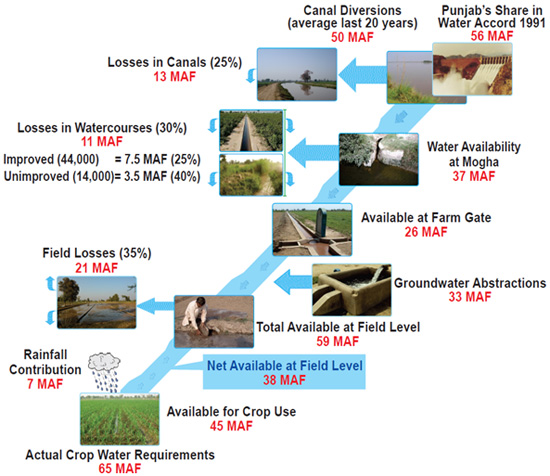 |
| Punjab Water Budget |
First ProjectThe first On Farm Water Management (OFWM) Project was initiated in October 1976 as a five-year pilot program, with assistance from the United States Assistance for International Development (USAID). The aim of this program was to promote participatory conservation of irrigation water at the farm level, by enhancing conveyance and application efficiencies, and water productivity. The project's primary objective was to improve overall irrigation efficiency, through community watercourse improvements, precision land leveling of farmers' fields, and adoption of advanced irrigation agronomic techniques. Its ultimate goal was to increase agricultural production and improve the income of low-income farmers in Pakistan. Although the project had a limited scope and duration, it served as a demonstration of increased food production and income from improved water management in selected areas. Various other OFWM projects were subsequently implemented throughout the province with funding from international donor agencies such as the World Bank, IDA, IFAD, OECF, Japan, ADB, and FAO. The project was not designed to achieve a significant increase in national food production on its own, but to provide evidence of the value of OFWM as a concept in agricultural planning, leading to the inclusion of OFWM in national planning, increased budgetary support, and replication of the project. |
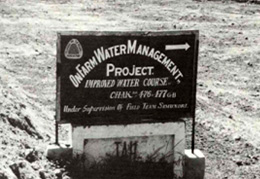 |
.
